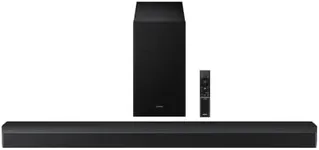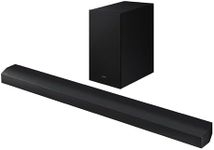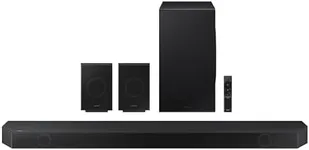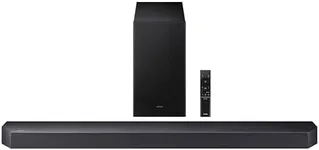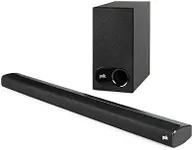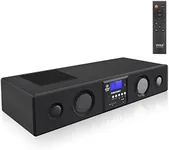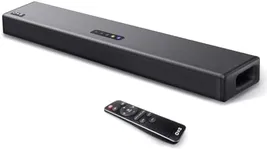Buying Guide for the Best Samsung Soundbars
Choosing the right soundbar can make a significant difference in how you enjoy movies, music, and TV shows at home. Soundbars are a popular way to upgrade your TV's audio without having to set up a full home theater system. To pick the best soundbar for your needs, it's important to understand the main features and how they impact your experience. Think about the size of your room, the kind of content you watch, your preferred audio quality, and how you plan to connect your devices.Channels (e.g., 2.0, 2.1, 5.1, 7.1)Channels refer to the individual audio outputs within a soundbar. For example, a 2.0 system has two speakers (left and right), while a 2.1 adds a subwoofer for better bass. Systems with more channels, like 5.1 or 7.1, offer surround sound effects and provide a more immersive experience, which is helpful for movies and gaming. To choose, consider if you want basic stereo audio (2.0), enhanced bass (2.1), or full surround sound (5.1 and above). Larger rooms and action-packed content benefit from more channels, while smaller rooms or casual TV watching may only need a 2.0 or 2.1 setup.
Subwoofer (built-in or external)A subwoofer boosts the low-end (bass) sounds, adding depth and impact to music and movies. Soundbars can come with a built-in subwoofer or an external one, usually wireless. An external subwoofer typically delivers more powerful bass and can be placed anywhere in the room. Choose a soundbar with a subwoofer if you enjoy bass-heavy content like movies, gaming, or music genres with strong low notes. If you have limited space, a built-in subwoofer may suffice.
Sound Modes and EqualizationSoundbars often offer different sound modes (like movie, music, dialogue, or night mode) and custom equalization settings. These allow you to adjust how the audio sounds to better match what you are listening to. For example, a movie mode might emphasize effects and dialogue, while music mode gives a balanced sound for songs. If you prefer one type of content, or if you watch TV in a shared space where loud sounds could disturb others, look for versatile sound modes that fit your preferences.
Connectivity Options (HDMI, Bluetooth, Optical, WiFi, etc.)Connectivity determines how you hook up your soundbar to other devices. HDMI (ARC or eARC) generally provides the best quality and allows you to control your soundbar with your TV remote. Optical inputs are also common for TVs. Bluetooth and WiFi let you stream music from your phone or other devices wirelessly. Decide what devices you want to connect and check if the soundbar supports those options. If you like streaming music or want a cleaner setup with fewer wires, wireless options are useful.
Size and DesignSoundbars come in various sizes and shapes, designed to fit different TV setups and room layouts. The right size should fit comfortably under or in front of your TV without blocking the screen or remote sensor. Long, slim soundbars can be better suited for larger TVs, while compact designs fit smaller rooms. Pick a size and style that complements your space and matches your TV for both aesthetic and practical reasons.
Voice Assistant and Smart FeaturesSome soundbars include built-in voice assistants (like Alexa or Google Assistant) or offer compatibility with smart home devices. These features allow you to control your soundbar and other smart gadgets by voice, play music hands-free, or integrate into your smart home system. If you already use smart features or want more convenience, consider soundbars with these capabilities.
Surround Sound Technology (Dolby Atmos, DTS:X, etc.)Advanced sound technologies like Dolby Atmos or DTS:X create a sense of 3D sound, making audio seem like it’s coming from all directions, even above you. This can greatly enhance the cinematic experience at home. If you are a movie enthusiast or want the most immersive sound possible, look for models that support these technologies. For casual viewing, basic surround sound or standard audio may be sufficient.
